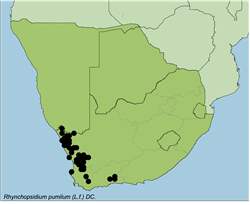Names and synonyms
Rhynchopsidium pumilum (L.f.) DC.
= Relhania pumila (L.f.) Thunberg
=Athanasia pumila Linne f.
=Eclopes pumila (L.f.) Lessing
=Nanophytum pumilum DC.
=Zoegea capensis Linne f.
=Relhania pedunculata L'Herit. (non (DC.) Harv.), nom. superfl.
=Relhania laxa L'Herit. var. humilis S. Moore
=Relhania laxa L'Heritier
=Rhynchopsidium pedunculatum =Relhania pedunculata (DC.) Harv. (non L'Herit.), nom. illeg.
Type
Thunberg, Herb. No. 20096, depressions near Brandvlei (UPS-THUNB, C, LD-RETZ, S).
Common names
Yellow snow; geelsneeu, teebossie
Derivation of names
Rhynchopsidium: rhunkhos = snout / beak; optos = seen / idion = diminutive
pumilum = dwarf, alluding to the small stature.
Genus name alludes to the fruit.
Diagnostic characters
Pappus with barbellate bristles
Description
A small, spindly, spreading, annual herb, 0.07-0.2(-0.25) m tall. Stems and branches erect or ascending, leafy, glabrous or tomentose, with stalked glands. Leaves linnear, needle-like, 5-30 x 0.4-2 mm, with sticky, stalked glandular hairs. Capitula solitary, terminal, 15-20 mm in diameter, on short peduncles, florets yellow. Peduncles 2-20 mm long. Involucre urn-shaped and wider at the base, almost orbicular in outline, 2-10 mm wide. Involucral bracts in 5 rows, 10-35, outer ovate, inner ovate-oblong with a spreading, brown, scarious apical limb, up to 5.5 x 2.5 mm, acute-obtuse. Receptacle flat-convex, paleate. Paleae lanceolate, 3-5.5 x 0.6-1.3 mm, acute. Ray florets 4-15, tube 1.2-2 mm long, lamina elliptic, 2-15 x 1-6 mm, 4-10-veined. Disc florets 8-150, perfect. Pappus crownlike, of � connate scales, up to 0.6 mm long. Cypsela narrowly elliptic, 1.5-2.5 x 0.3-0.6 mm, densely villose with apically hooked hairs.
Flowering time
Mainly from August to October (to November)
Distribution
Occurs mainly in Namaqualand, but extends further south into the southwestern districts and occasionally further east to Oudtshoorn and the Klein Karoo.
Known from more than 90 specimens.
Habitat
Abundant in disturbed clayey or sandy soils especially on flat, open areas.
Notes
In good seasons this species is superficially similar to Leysera tenella , but can be distinguished by the broader involucre.
References
ANDERBERG, A.A. & BREMER, K. 1991. Parsimony analysis and cladistic reclassification of the Relhania generic group (Asteraceae - Gnaphalieae). Annals of the Missouri Botanical Garden 78: 1061-1072.
BREMER, K. 1976. The genus Relhania (Compositae). Opera Botanica 40.
GLEN, H.F. 2004. SAPPI, What's in a Name? The Meanings of the Botanical Names of Trees. Jacana.
KESTING, D. & CLARKE, H. 2008. Botanical names, what they mean. Wild Flowers of the Cape Peninsula, 3rd revised edition. Friends of Silvermine.
LE ROUX, A. 2005. Namaqualand, South African Wild Flower Guide 1. Botanical Society of South Africa.
MANNING,J. 2003. Photographic Guide to the Wildflowers of South Africa. Briza Publications.
MANNING, J. 2009. Field guide to Wild Flowers of South Africa, Lesotho and Swaziland. Struik Nature.
VLOK, J. & SCHUTTE-VLOK, A L. 2010. Plants of the Klein Karoo. Umdaus Press

_sml.jpg)
_sml.jpg)
_sml.jpg)
_sml.jpg)
_sml.jpg)
_sml.jpg)
_sml.jpg)
_sml.jpg)